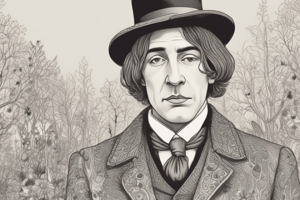Podcast
Questions and Answers
Why is the Giant called selfish?
Why is the Giant called selfish?
The Giant is called selfish because he built a high wall around his garden to prevent children from playing in it, wanting the garden to be for himself only.
What are the children referring to when they said: 'How happy we are here!' and later, 'How happy we were there!'?
What are the children referring to when they said: 'How happy we are here!' and later, 'How happy we were there!'?
They are referring to their enjoyment of playing in the Giant's garden.
(i) When spring came, it was still winter in the garden. What does winter stand for or indicate here?
(i) When spring came, it was still winter in the garden. What does winter stand for or indicate here?
Winter indicates the loneliness and desolation of the Giant's garden due to his selfishness.
(ii) Winter has been presented like a story with its own characters and their activities. Describe the story in your own words.
(ii) Winter has been presented like a story with its own characters and their activities. Describe the story in your own words.
Was the Giant happy or sad over the state of the garden?
Was the Giant happy or sad over the state of the garden?
What effect did the linnet's song have on Hail and the North Wind?
What effect did the linnet's song have on Hail and the North Wind?
What did the Giant realize after seeing the little boy in the garden?
What did the Giant realize after seeing the little boy in the garden?
Why was it still winter in one corner of the garden?
Why was it still winter in one corner of the garden?
Describe the first meeting of the little boy and the Giant.
Describe the first meeting of the little boy and the Giant.
Describe their second meeting after a long interval.
Describe their second meeting after a long interval.
What does the sentence 'The Giant lay dead, all covered with white blossoms' indicate about the once selfish Giant?
What does the sentence 'The Giant lay dead, all covered with white blossoms' indicate about the once selfish Giant?
Flashcards are hidden until you start studying
Study Notes
The Selfish Giant - Summary
- The Giant's beautiful garden was once a playground for local children until he built a wall to keep them out.
- After seven years away, he discovers children playing in his garden and drives them away, declaring it his alone.
- Spring and Summer do not come to the garden due to the Giant's selfishness, resulting in a perpetual winter.
- Snow, Frost, North Wind, and Hail inhabit the garden, reveling in the absence of children and Spring.
- The Giant realizes that his selfishness is the reason for the bleak winter when he hears a linnet singing, indicating Spring's arrival.
The Giant’s Change of Heart
- Upon witnessing children joyfully playing again, the Giant longs for their return, especially a little boy he loves.
- He sees a small boy who cannot reach the tree branches and feels remorse for his selfishness.
- The Giant vows to knock down the wall and transform his garden into a children’s playground, recognizing his wrongdoings.
The Reunion with Children
- The Giant’s kindness brings back Spring as children return to the garden.
- He lifts the little boy into a tree, causing blossoms to appear and birds to sing.
- The first act of kindness leads to joyful play, but the boy mysteriously disappears, leaving the Giant saddened by his absence.
- Over the years, the Giant grows old and feeble yet finds joy in watching children play in the garden.
The Final Encounter
- One winter morning, the Giant sees a tree covered in white blossoms and a familiar little boy beneath it.
- The boy has marks of nails on his hands and feet, symbolizing love and sacrifice, which fills the Giant with awe and reverence.
- The boy invites the Giant to his garden, revealing an offer of paradise, leading the Giant to recognize the deeper meaning of love and redemption.
- The Giant dies peacefully in the garden, surrounded by white blossoms, indicating his transformation from a selfish being to one marked by love and sacrifice.
Themes and Symbols
- Selfishness vs. Selflessness: The Giant's initial selfishness leads to sorrow, but through love and kindness, he finds redemption.
- Nature and Transformation: The garden’s seasonal changes reflect the Giant’s emotional state and his gradual change toward generosity.
- Innocence of Childhood: The children's return symbolizes joy, purity, and the transformative power of love within the community.
- Sacrifice: The nail marks on the boy’s hands and feet represent a greater narrative of love, sacrifice, and perhaps a connection to Christ-like imagery.
Important Characters
- The Giant: Initially selfish, he learns to love and share by the end of the story.
- The Children: Represent innocence and joy, whose presence brings life to the garden.
- The Little Boy: Symbolizes love and redemption; connects the Giant’s journey to a spiritual awakening.
Studying That Suits You
Use AI to generate personalized quizzes and flashcards to suit your learning preferences.




